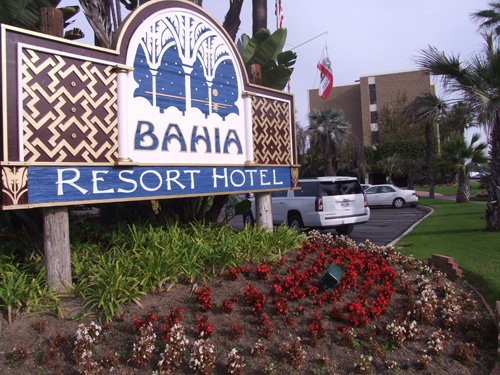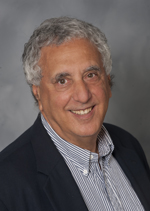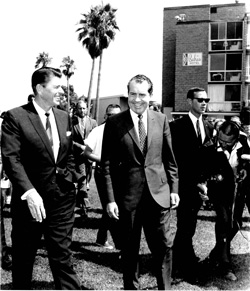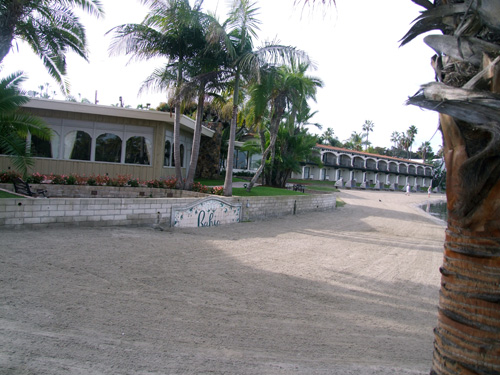
Editor’s Note: In my quest to find Jewish stories wherever I go, I decided there is no place like home to illustrate the concept that “there is a Jewish story everywhere.” Interstate 8 roughly follows the traditional route that settlers took in their covered wagons in the mid-19th century to get to San Diego from the American Southeast. In this I-8 travel series, I plan to reverse their route, and to travel inland from the coast of California, heading east on the I-8 until I reach that freeway’s terminus in Arizona. Along the way, I will take readers to venues within a few miles of the freeway’s exits. Please note that over I-8’s California segment, the number designation of a freeway exit corresponds with that exit’s distance from the western terminus of I-8, which we call Mile 0. Throughout this series, which we plan to run on Thursdays, we will use those numbers as aids to help our readers find the places we visit.
Mile 1: West Mission Bay Drive: Bahia Hotel, Mission Bay, San Diego
By Donald H. Harrison


SAN DIEGO — In August 1968, right after Republicans nominated him for the presidency of the United States, Richard M. Nixon traveled from Miami Beach to San Diego with a stopover in Texas to be briefed by vacationing U.S. President Lyndon B. Johnson about the progress of the Vietnam War.
Following his meeting with Johnson, candidate Nixon said that he would refrain from making political comments about the war while there was a chance that the Paris Peace Talks with representatives of North Vietnam might bear fruit. So what would Nixon and his vice presidential running mate, the relatively unknown governor of Maryland, Spiro Agnew, emphasize in their joint campaign against a Democratic nominee who was soon to be selected?
Hoping to find out, news reporters and pundits accompanied Nixon to the Bahia Hotel on Mission Bay where he and his family and staff had set aside one week, August 11-17, to discuss strategy and to vacation following the grueling primary campaign in which Nixon had outmaneuvered Nelson Rockefeller on his left and Ronald Reagan on his right.
Nixon, his family, and his closest staff stayed in a block of 40 bayside rooms of the Bahia Hotel, while news media and lower ranking staff members stayed at the Catamaran Hotel several blocks away on Mission Boulevard. Both hotels were owned by William and Anne Evans, loyal San Diego Republicans. Located on a 14-acre peninsula, the then 15-year-old Bahia Hotel satisfied the Secret Service’s security requirements, although its presidential suite did not. That suite was deemed too close to the public view to be adequate for security purposes. The Nixons were put up in a room near the end of the peninsula.
While at the Bahia, Agnew and high ranking campaign officials made it known that the Nixon campaign planned to stress the need to quell the violence and civil unrest that had erupted across America earlier that year in the wake of the assassinations of civil rights leader Rev. Martin Luther King and Bobby Kennedy. They also opposed anti-Vietnam War violence.
During the week he stayed at the Bahia, Nixon did not yet know that Johnson’s Vice President, Hubert Humphrey, would emerge from the Aug. 26-29 Democratic National Convention as the presidential nominee and that U.S. Senator Edmund Muskie of Maine would be the Democrats’ choice to occupy the vice presidential position that both Nixon and Humphrey had held. Nor did Nixon know that violence between police and protestors outside the Chicago convention hall would become as big a story as Humphrey’s nomination.

While preparing for his campaign against whatever Democratic rival might emerge, Nixon spent much of his time in San Diego on the telephone mending fences with the liberal Republican leaders who had supported Rockefeller’s failed presidential bid, and with conservatives who had backed Reagan.
After winning public endorsements from Rockefeller and New York Mayor John Lindsay, Nixon announced at the Bahia that he would soon travel to New York City for personal meetings with the two leaders.
Whereas Rockefeller and Lindsay were quick to pledge their support for their party nominee, another important New York Republican — U.S. Senator Jacob Javits– was playing his cards closer to his vest. The Jewish Republican was considered by many to be one of the most liberal members of the Senate as well as an outspoken opponent of the war in Viet Nam. Before he would climb aboard his party leader’s campaign band wagon, Javits wanted to hear for himself exactly how Nixon viewed the Viet Nam problem. From his room in the Bahia, Nixon made an appointment to see him as well–an appointment that ultimately resulted in Javits’ endorsement.
During the week-long working vacation, Nixon met at the Bahia Hotel with at least two other well-known Jewish political figures. Arthur Burns had served as chairman of the Council of Economic Advisors during the administration of Dwight D. Eisenhower at the same time as Nixon was the nation’s vice president. Burns subsequently would be named by Nixon as a Cabinet-level counselor to the President and, later, as chairman of the Federal Reserve Bank — their conversation at the Bahia a step toward those appointments.
One of Burns’ former students at Rutgers University, who had made quite a name for himself as a conservative economist, Milton Friedman, also met with Nixon at the Bahia. Although Friedman would be called upon by Nixon for advice now and then, it was not until the Reagan administration began in 1981 that Friedman would become widely recognized as a shaper of American economic policy.
A highlight of Nixon’s stay was his meeting at the Bahia with California Governor Ronald Reagan, who himself would be destined to win the presidency in 1980. In a joint news conference, Nixon and Reagan told the media that Reagan would campaign for Nixon in California, and from time to time would go out on the national campaign trail as his responsibilities as governor permitted.
Besides wanting to unify the Republican party behind him, Nixon in the words of Press Secretary Herb Klein wanted to lay out with Agnew what they hoped would be “the most coordinated dual campaign in American political history.”
In his book, The Selling of the President 1968, Joe McGinnis reported that such a campaign was easier announced than accomplished. One of Nixon’s Jewish advisors, attorney Leonard Garment, was tasked with looking over documentary film footage about Agnew that had been shot on the Bahia grounds by a hapless and unnamed interviewer. Besides being often out of focus, the film was rendered unusable by boring questions and answers. For example, the interviewer asked whether Agnew was happy to be chosen as the vice presidential nominee.
As McGinnis reported it: “‘The ability to be happy is directly proportional to the ability to suffer,’ Agnew said. His tone indicated he might doze before finishing the sentence, ‘and as you grow older you feel everything less.’ He stopped. There was silence on the film. Then the voice of the interviewer: ‘I see.'”
Garment commented about the film: “It looks like you’re looking through a Coke bottle.”
And about Agnew’s on-camera performance, Garment added sadly: “He is rather nondynamic.”
There is a Jewish story everywhere. As was the case with Javits, Burns, Friedman and Garment, sometimes “Jewish stories” constitute strands in the tapestry of a much larger tale.
{Directions to Bahia Hotel from the West Mission Bay Boulevard. Follow West Mission Bay Boulevard signs through the interchange, and watch for the Bahia Hotel on the right. If you get to Mission Boulevard, you have just passed it.}
*
Next in the I-8 series: Mile 1: San Diego Sports Arena, A,K.A. Valley View Casino Center
*
Harrison is editor of San Diego Jewish World. You may comment to him at donald.harrison@sdjewishworld.com or post your comment on this website provided that the rules below are observed.
__________________________________________________________________
Care to comment? We require the following information on any letter for publication: 1) Your full name 2) Your city and state (or country) of residence. Letters lacking such information will be automatically deleted. San Diego Jewish World is intended as a forum for the entire Jewish community, whatever your political leanings. Letters may be posted below provided they are responsive to the article that prompted them, and civil in their tone. Ad hominem attacks against any religion, country, gender, race, sexual orientation, or physical disability will not be considered for publication. There is a limit of one letter per writer on any given day.
__________________________________________________________________